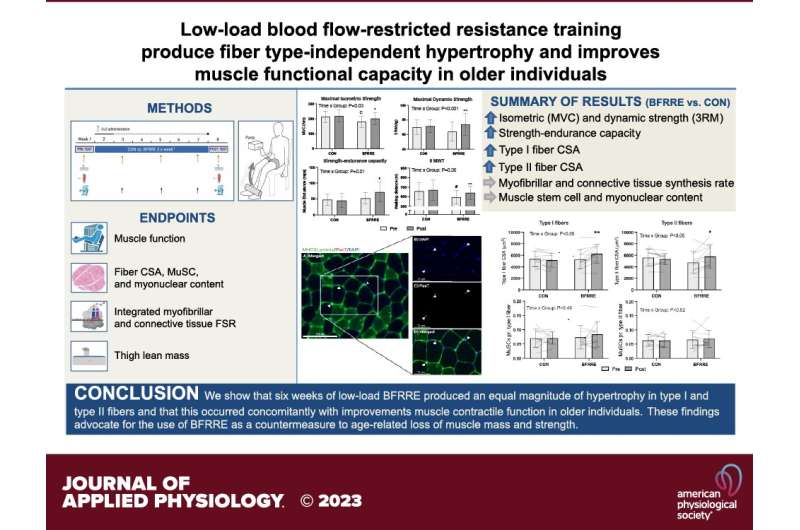This article has been reviewed according to Science X's editorial process and policies. Editors have highlighted the following attributes while ensuring the content's credibility:
fact-checked
peer-reviewed publication
trusted source
proofread
Blood-flow-restricted resistance exercise could help counteract age-related muscle loss

Low-load, blood-flow-restricted resistance exercise (BFRRE), a form of strength training during which a pressure cuff partially restricts blood flow to the target muscle group, has been growing in popularity. New research out of Aarhus University in Denmark suggests that this exercise technique could reduce age-related muscle loss. The study is published ahead of print in the Journal of Applied Physiology.
The ability to maintain muscle mass and function as we age is associated with improved quality of life, metabolic health and longevity. BFRRE allows users to build muscle mass while avoiding the injury risk that comes with heavier weights.
Researchers split 23 healthy, older adults who did not typically participate in high-intensity physical activity into two groups. One group participated in a six-week BFRRE program, while a group of control volunteers maintained their current daily activity level.
Before and after the intervention, researchers evaluated both groups for muscle strength and endurance. They used dual-energy X-ray absorptiometry scans to measure body composition and took biopsies of the participants' thigh muscles.
The exercise group completed four sets of bilateral knee extensions (until they tired) three times a week under supervision. Researchers calibrated weight load to 30% of each person's maximum capacity and adjusted it three times over the course of the study. Researchers also determined individualized levels of blood-flow-restricting pressure for each participant, averaging 97 millimeters of mercury. On average, a full session took less than seven minutes.
The exercise group saw improvements in multiple measures of muscle strength and endurance, including an improvement in walking capacity. In the biopsies, the cross-sectional area of both slow- and fast-twitch muscles also increased in size. The control group saw no such changes.
"Notably, since these results were obtained with a modest exercise volume and in a very time-efficient manner, BFRRE may represent a potent exercise strategy to counteract age-related muscle decay," researchers wrote.
More information: Jakob Wang et al, Low-load blood flow-restricted resistance exercise produces fiber type-independent hypertrophy and improves muscle functional capacity in older individuals, Journal of Applied Physiology (2023). DOI: 10.1152/japplphysiol.00789.2022





















